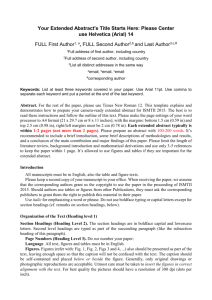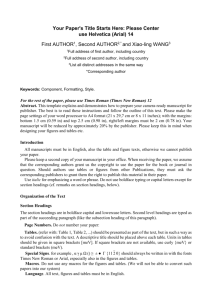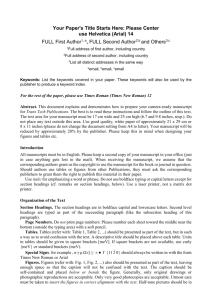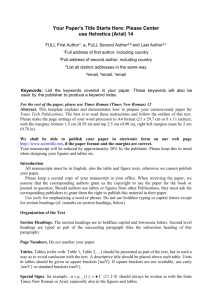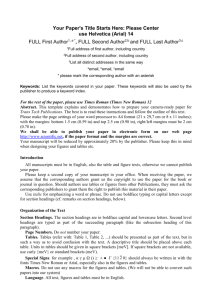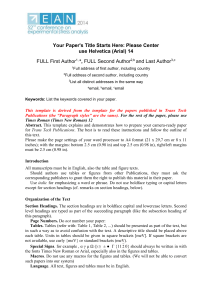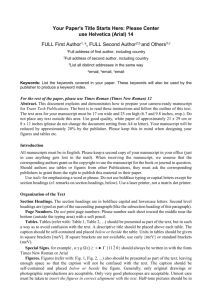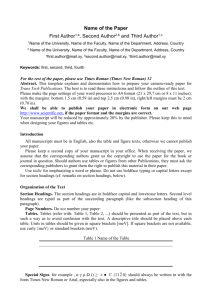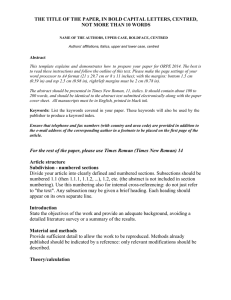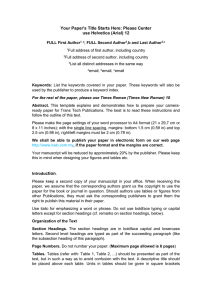the template of the
advertisement
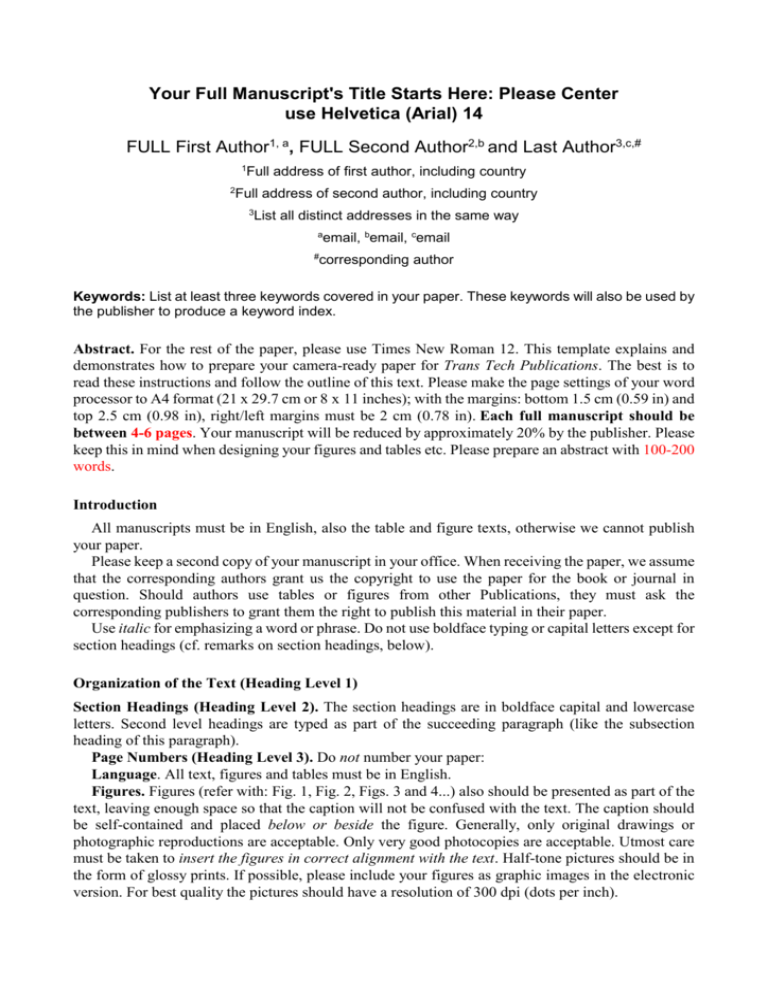
Your Full Manuscript's Title Starts Here: Please Center
use Helvetica (Arial) 14
FULL First Author1, a, FULL Second Author2,b and Last Author3,c,#
1
Full address of first author, including country
2
Full address of second author, including country
3
List all distinct addresses in the same way
a
email, bemail, cemail
#
corresponding author
Keywords: List at least three keywords covered in your paper. These keywords will also be used by
the publisher to produce a keyword index.
Abstract. For the rest of the paper, please use Times New Roman 12. This template explains and
demonstrates how to prepare your camera-ready paper for Trans Tech Publications. The best is to
read these instructions and follow the outline of this text. Please make the page settings of your word
processor to A4 format (21 x 29.7 cm or 8 x 11 inches); with the margins: bottom 1.5 cm (0.59 in) and
top 2.5 cm (0.98 in), right/left margins must be 2 cm (0.78 in). Each full manuscript should be
between 4-6 pages. Your manuscript will be reduced by approximately 20% by the publisher. Please
keep this in mind when designing your figures and tables etc. Please prepare an abstract with 100-200
words.
Introduction
All manuscripts must be in English, also the table and figure texts, otherwise we cannot publish
your paper.
Please keep a second copy of your manuscript in your office. When receiving the paper, we assume
that the corresponding authors grant us the copyright to use the paper for the book or journal in
question. Should authors use tables or figures from other Publications, they must ask the
corresponding publishers to grant them the right to publish this material in their paper.
Use italic for emphasizing a word or phrase. Do not use boldface typing or capital letters except for
section headings (cf. remarks on section headings, below).
Organization of the Text (Heading Level 1)
Section Headings (Heading Level 2). The section headings are in boldface capital and lowercase
letters. Second level headings are typed as part of the succeeding paragraph (like the subsection
heading of this paragraph).
Page Numbers (Heading Level 3). Do not number your paper:
Language. All text, figures and tables must be in English.
Figures. Figures (refer with: Fig. 1, Fig. 2, Figs. 3 and 4...) also should be presented as part of the
text, leaving enough space so that the caption will not be confused with the text. The caption should
be self-contained and placed below or beside the figure. Generally, only original drawings or
photographic reproductions are acceptable. Only very good photocopies are acceptable. Utmost care
must be taken to insert the figures in correct alignment with the text. Half-tone pictures should be in
the form of glossy prints. If possible, please include your figures as graphic images in the electronic
version. For best quality the pictures should have a resolution of 300 dpi (dots per inch).
Color figures are welcome for the online version of the journal. Generally, these figures will be
reduced to black and white for the print version. The author should indicate on the checklist if he
wishes to have them printed in full color and make the necessary payments in advance.
Tables. Tables (refer with: Table 1, Table 2, Tables 3 and 4, ...) should be presented as part of the
text, but in such a way as to avoid confusion with the text. A descriptive title should be placed above
each table. Units in tables should be given in square brackets [meV]. If square brackets are not
available, use curly {meV} or standard brackets (meV).
Fig. 1. Banner of ISMTII 2015
Table Head
1
Table 1. An table example
Table Column Head
Subhead
Subhead
2
3
Subhead
4
Equations. Equations (refer with: Eq. (1), Eq. (2), Eqs. (3) and (4), …) should be indented 5 mm
(0.2"). There should be one line of space above the equation and one line of space below it before the
text continues. The equations have to be numbered sequentially, and the number put in parentheses at
the right-hand edge of the text. Equations should be punctuated as if they were an ordinary part of the
text. Punctuation appears after the equation but before the equation number, e.g.
F = ma.
(1)
where boldface symbols are commonly used for vectors and regular symbols are used for scalars.
Special Signs. for example , α γ μ Ω () ≥ ± ● Γ {11 2 0} should always be written in with the fonts
Times New Roman or Arial, especially also in the figures and tables.
Macros. Do not use any macros for the figures and tables. (We will not be able to convert such
papers into our system)
Literature References
References are cited in the text just by square brackets [1]. (If square brackets are not available,
slashes may be used instead, e.g. /2/.) Two or more references at a time may be put in one set of
brackets [3,4]. The references are to be numbered in the order in which they are cited in the text and
are to be listed at the end of the contribution under a heading References, see our example below.
Summary
If you follow this guideline, your paper will conform to the requirements of the publisher and
facilitate a problem-free publication process.
References
[1] J. van der Geer, J.A.J. Hanraads, R.A. Lupton, The art of writing a scientific article, J. Sci.
Commun. 163 (2000) 51-59.
[2] W. Strunk Jr., E.B. White, The Elements of Style, third ed., Macmillan, New York, 1979.
[3] G.R. Mettam, L.B. Adams, How to prepare an electronic version of your article, in: B.S. Jones,
R.Z. Smith (Eds.), Introduction to the Electronic Age, E-Publishing Inc., New York, 1999, pp.
281-304.
[4] R.J. Ong, J.T. Dawley, P.G. Clem: submitted to Journal of Materials Research (2003)
[5] P.G. Clem, M. Rodriguez, J.A. Voigt, C.S. Ashley, U.S. Patent 6,231,666. (2001)
[6] Information on http://www.weld.labs.gov.cn
[7] P.T. Lin, H.C. Gea, Y. Jaluria, A Modified Reliability Index Approach for Reliability-Based
Design Optimization, 2009 ASME International Design Engineering Technical Conferences &
Computers and Information in Engineering Conference (IDETC/CIE), San Diego, CA, USA. (2009)
DETC2009-87804.
[8] P.T. Lin, Parametric Modeling and Optimization of Thermal Systems with Design Uncertainties,
PhD Dissertation, Department of Mechanical and Aerospace Engineering, Rutgers University, 2010.
